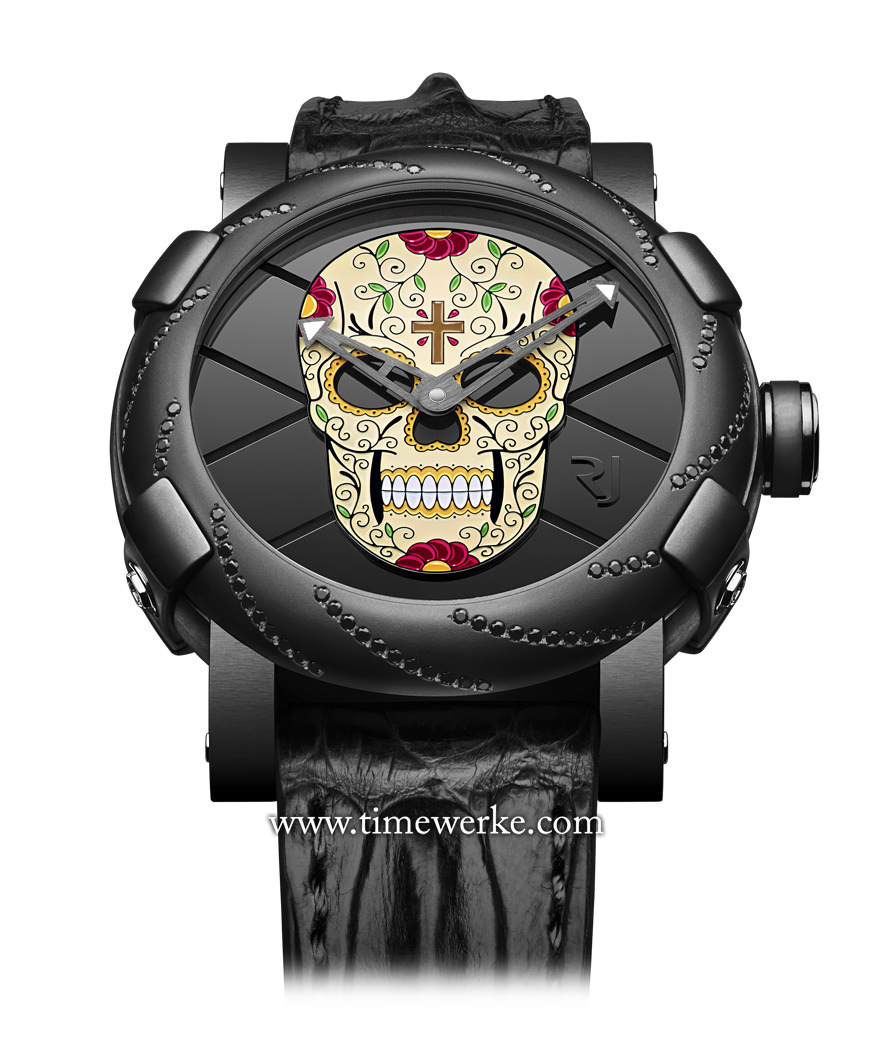
Romain Jerome’s Día de los Muertos on a black PVD-coated steel case. Five versions are available. Photo: © Romain Jerome
The skull symbol should not be only associated with the dark side such as evil and death. Since ancient times, the skull symbol has served as a reminder of our mortality.
The first thing that comes to mind for those who view the skull as a celebration of life as opposed to death will be the Latin phrase memento mori or “remember you must die” when translated to English.
In Mexico, North America and Canada, Latin Americans celebrate a holiday every November known as the “Day of the Dead” or El Día de los Muertos. It is also known as “All Souls’ Day”, a day to honour family members and friends who have passed on.
The skull is a common symbol used during the celebrations and even food offering of sugar skulls are made for both the living and the dead.
These days, the skull symbol is also used by apparel and accessory brands as a fashion statement.
However, for watch brand Romain Jerome, it has instead created five versions of a black PVD-coated (particle vapour deposition) steel watch that specially celebrates El Día de los Muertos or the Mexican Day of the Dead.
Romain Jerome’s colourful versions of its Día de los Muertos watches lean toward the artistic side and therein lies the interest and beauty of such timepieces, in addition to the cultural link of these skull symbols.
While the skull is prominent, those who enjoy skull and crossbones symbols should not be crossed (pun most definitely intended) for Romain Jerome has not forgotten the crossbones. Design-wise, the cross that is seen behind the skull represents the crossbones.
The skull symbol is also a symbol used by the military. The late Chris Kyle, a former sniper from the elite US Navy SEAL unit, mentions in the book “American Sniper” that his platoon had adopted the skull symbol because they named themselves the “Punishers”.
This name was inspired by the Marvel comics character the Punisher who first appeared in a 1974 Spiderman comic feature. The Punisher sought vigilante justice on criminals.
Speaking of the punisher, we had only yesterday witnessed misguided justice played out like a comic strip.
At a private residential estate, we witnessed how a slightly pudgy, middle-aged and balding Caucasian man allowed his toy breed dog to freely urinate and defecate on the concrete pavements and asphalt road without realising the civilised (and perhaps legal) need to clean up, notably the solid excrement.
However, he appeared terribly crossed with cars which had stopped at a side of a road for less than five minutes to pick up their young children who had just finished lessons at a private school located within this same residential estate.
It was comical because it was hilarious watching the agitated pudgy man holding onto his dog leash while fumbling with what seemed like an iPad to capture either still images or videos of the cars which had stopped temporarily.
Perhaps he wanted to be a “punisher” by gathering “documentary proof” to lodge complaints against the parents’ driving misdeeds. What was bewildering was his thinking that stopping one’s car at the roadside was wrong yet it was perfectly above board to have his pet litter the estate with faecal matter.
So what was truly vulgar? Stopping one’s car to pick up a child or blatantly leaving a pet’s solid excrement on asphalt?
Well, the answer is obvious, especially when a family member of any of the more than 600 household units in this particular estate accidentally steps on the poop and instinctively screams its vulgar term out loud.


